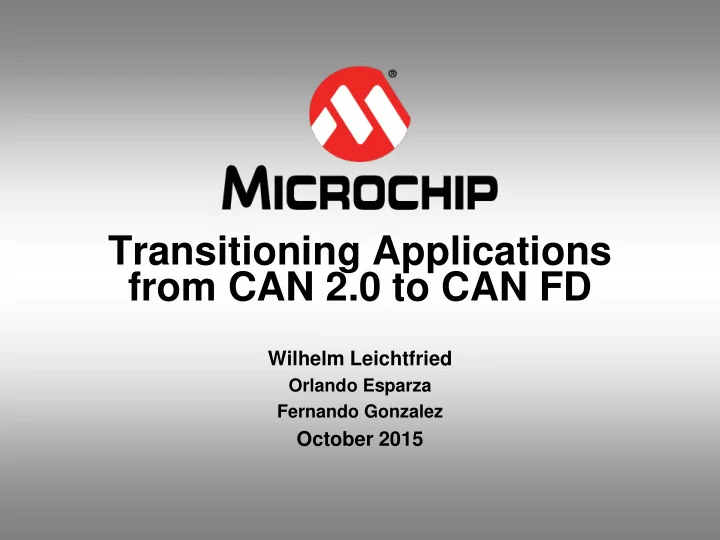

Transitioning Applications from CAN 2.0 to CAN FD Wilhelm Leichtfried Orlando Esparza Fernando Gonzalez October 2015
Application Driver Door Module 2
Requirements CAN 2.0 DDM Analog: Temperature Sensor Inputs: door lock, window lift, mirror control, door ajar Outputs: window and door lock driver Interior Lighting: LED intensity control Communication: CAN 2.0 : 500kb/s; 75% sample point +/-0.4% bit time tolerance LIN : 19.2kb/s; for mirror control 3
Communication: CAN 2.0 4
MCU CAN 2.0 HW FLASH LIN UART RAM Transceiver CPU CAN CAN 2.0 48 MHz PLL 2.0 Transceiver 8 MHz Window Temperature A2D Motor Sensor Digital Out Door Lock Door Lock Door Ajar Driver Mirror Control Digital In Window Lift LED PWM Control Driver 5
CAN 2.0 FW Application Temp. Sensing Window Lift Door Un/Lock Interior LIN Network CAN Network Lighting Management Management I/O Abstraction Comm. Hardware Abstraction CAN Interface I/O Interface LIN Interface I/O Drivers Communication Drivers I/O Driver UART Driver CAN Driver MCU Peripherals I/O UART CAN LIN CAN 2.0 Transceiver Transceiver 6
Development Effort Hardware design: 1 TQ Firmware design: 3-5 TQ Validation: 3-5 TQ 7
Motivation for CAN FD OEM face bandwidth issues EOL programming Growth of features Limits of CAN 2.0 500kb/s data rate 8 data bytes per message Solution -> CAN FD 500kb/s arbitration phase; 2Mb/s data phase 5 to 8Mb/s programming 64 data bytes per message 8
CAN 2.0 vs. CAN FD 9
Requirements CAN FD DDM Temperature – send data more often Inputs: door lock, window lift, mirror control, door ajar Outputs: window and door lock driver Interior Lighting: RGB LED Communication: CAN FD : 500kb/s-2Mb/s; 75.0% sample point; +/-0.4% bit time tolerance; 40 (or 20 or 80) MHz CAN clock LIN : for mirror control 10
MCU CAN FD HW FLASH FLASH LIN UART RAM RAM Transceiver CPU CAN CAN 2.0 CAN FD CAN 64 MHz 48 MHz FD Transceiver Transceiver PLL 2.0 40 MHz 8 MHz Window Temperature A2D Motor Sensor Digital Out Door Lock Door Lock Door Ajar Driver Mirror Control Digital In RGB LED 4x Window Lift LED PWM Driver PWM Control Driver 11
CAN FD FW Application Temp. Sensing Window Lift Door Un/Lock RGB Interior Interior LIN Network CAN Network CAN FD Management Lighting Lighting Management Network M. I/O Abstraction Comm. Hardware Abstraction CAN Interface CAN FD Interf. I/O Interface LIN Interface I/O Drivers Communication Drivers I/O Driver UART Driver CAN FD Driver CAN Driver MCU Peripherals I/O UART CAN FD LIN CAN FD Transceiver Transceiver 12
CAN FD MCU availability Limited number of CAN FD MCU Most MCUs are high end targeting Gateway applications Major re-design effort of HW and FW Major re-validation effort 13
New MCU FW Application Temp. Sensing Window Lift Door Un/Lock RGB Interior Interior LIN Network CAN Network CAN FD Management Lighting Lighting Management Network M. I/O Abstraction Comm. Hardware Abstraction CAN Interface CAN FD Interf. I/O Interface LIN Interface I/O Interface LIN Interface I/O Drivers Communication Drivers I/O Driver UART Driver CAN FD Driver CAN Driver I/O Driver UART Driver MCU Peripherals I/O UART CAN FD LIN CAN FD Transceiver Transceiver 14
MCU External FLASH Controller FLASH LIN UART RAM RAM Transceiver CPU CAN FD CAN FD CAN CAN 64 MHz SPI Transceiver Controller PLL 2.0 Transceiver 4 MHz Window Temperature A2D Motor Sensor Digital Out Door Lock Door Lock Door Ajar Driver Mirror Control Digital In RGB LED 4x Window Lift LED PWM Driver PWM Control Driver 15
External CAN FD Controller FW Application Temp. Sensing Window Lift Door Un/Lock RGB Interior LIN Network CAN FD Lighting Management Network M. I/O Abstraction Comm. Hardware Abstraction CAN FD Interf. I/O Interface LIN Interface I/O Drivers Communication Drivers CAN Driver I/O Driver UART Driver SPI Driver MCU Peripherals I/O UART SPI LIN CAN FD Transceiver Controller/XCVR 16
External Controller Benefit of Using an External Controller Maximize design re-use Minimize cost Keep microcontroller No need to upgrade to available high end CAN FD MCU Minimize re-validation Increased choices of MCU Easily add additional CAN FD channels 17
External CAN FD controller blockdiagram SPI Pins SPI Interface RAM CAN Clock Generation TX/RX Msg Objects TX/RX FIFOs Memory IF FIFO and CAN SFR Buffer Control RX Handler TX Handler INT Pins Acceptance TX Prioritization Mode CAN Filter Interrupts Control RXCAN Filter and Time BSP TXCAN Masks Stamping Bit Stream Processor 18
External CAN FD controller FAQ Are there security considerations? Add ECC to RAM Secure SPI with optional CRC What is the required SPI speed? 500k/2M -> 10MHz 500k/5M -> 12MHz SPI with DMA recommended 19
CAN FD bit time setup 20
Summary CAN 2.0 to CAN FD transition has begun Both Automotive and Industrial Lack of CAN FD capable MCUs Increases OEM/Supplier costs and complexities CAN FD External Controller is a viable alternative solution Maximizes hardware and firmware reuse 21
Questions / Demo 22
Recommend
More recommend